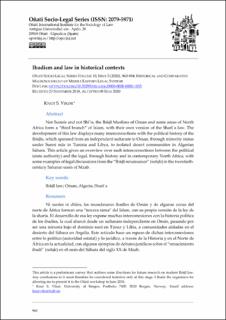| dc.contributor.author | Vikør, Knut S. | |
| dc.date.accessioned | 2021-07-13T10:44:16Z | |
| dc.date.available | 2021-07-13T10:44:16Z | |
| dc.date.created | 2021-01-25T17:57:08Z | |
| dc.date.issued | 2020 | |
| dc.Published | Oñati Socio-legal Series. 2020, 10 (5), 960-984. | |
| dc.identifier.issn | 2079-5971 | |
| dc.identifier.uri | https://hdl.handle.net/11250/2764267 | |
| dc.description.abstract | Not Sunnis and not Shi’is, the Ibāḍī Muslims of Oman and some areas of North Africa form a “third branch” of Islam, with their own version of the Sharīʿa law. The development of this law displays many interconnections with the political history of the Ibāḍīs, which spanned from an independent sultanate in Oman, through minority status under Sunni rule in Tunisia and Libya, to isolated desert communities in Algerian Sahara. This article gives an overview over such interconnections between the political (state authority) and the legal, through history and in contemporary North Africa, with some examples of legal discussions from the “Ibāḍī renaissance” (nahḍa) in the twentieth-century Saharan oasis of Mzab.
Ni suníes ni chiíes, los musulmanes ibadíes de Omán y de algunas zonas del norte de África forman una “tercera rama” del Islam, con su propia versión de la ley de la sharía. El desarrollo de esa ley expone muchas interconexiones con la historia política de los ibadíes, la cual abarcó desde un sultanato independiente en Omán, pasando por ser una minoría bajo el dominio suní en Túnez y Libia, a comunidades aisladas en el desierto del Sáhara en Argelia. Este artículo hace un repaso de dichas interconexiones entre lo político (autoridad estatal) y lo jurídico, a través de la Historia y en el Norte de África en la actualidad, con algunos ejemplos de debates jurídicos sobre el “renacimiento ibadí” (nahḍa) en el oasis del Sáhara del siglo XX de Mzab. | en_US |
| dc.language.iso | eng | en_US |
| dc.publisher | Oñati International Institute for the Sociology of Law | en_US |
| dc.relation.uri | http://opo.iisj.net/index.php/osls/article/view/1094 | |
| dc.rights | Attribution-NonCommercial-NoDerivatives 4.0 Internasjonal | * |
| dc.rights.uri | http://creativecommons.org/licenses/by-nc-nd/4.0/deed.no | * |
| dc.title | Ibadism and Law in Historical Contexts | en_US |
| dc.type | Journal article | en_US |
| dc.type | Peer reviewed | en_US |
| dc.description.version | publishedVersion | en_US |
| dc.rights.holder | Copyright the author | en_US |
| cristin.ispublished | true | |
| cristin.fulltext | preprint | |
| cristin.qualitycode | 1 | |
| dc.identifier.doi | 10.35295/osls.iisl/0000-0000-0000-1155 | |
| dc.identifier.cristin | 1878929 | |
| dc.source.journal | Oñati Socio-legal Series | en_US |
| dc.source.40 | 10 | |
| dc.source.14 | 5 | |
| dc.source.pagenumber | 960-984 | en_US |
| dc.identifier.citation | Oñati Socio-legal Series. 2020, 10 (5), 960-984. | en_US |
| dc.source.volume | 10 | en_US |
| dc.source.issue | 5 | en_US |

